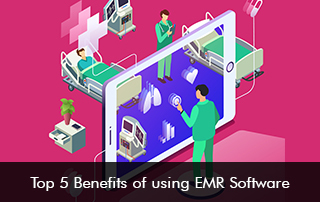Healthcare systems and hospitals have embraced certified EHR software solutions because of their many benefits and billions of dollars in incentives provided by the CMS. In 2021, 96 percent of acute care hospitals and 78 percent of office-based physicians have leveraged Electronic Medical Records Software technology. The high percentage reflects how these robust solutions streamline workflows and boost productivity levels.
How does an EHR system work?
Electronic medical records software has replaced traditional paper-based records. The paper-based records were inefficient and took up lots of office space.
EHR solutions have patient data digitally stored in them. The system allows healthcare providers to enter patient data and easily update it. The records include all important patient details such as family history, medication history, allergies, and lab tests that support the patient’s diagnosis and treatment path.
Key features in EMR software
A top-ranked and modern Electronic Medical Records (EMR) Software system will offer the following functionalities to optimize workflows and enhance productivity levels:
- Cloud-based functionality
- Full-featured mobile app
- Care management tools
- Charting features such as voice recognition capabilities
- E-Rx tools
- Seamless integration with controlled substance database
- Patient scheduling
- Appointment reminders
- MIPS support
- Patient Portal
- Billing features
- HIPAA-compliance
EHR software benefits clinicians
- Quick access to patient records – The use of EMR technology by providers offer them prompt access to patient records. This way they are well-informed to provide the right patient diagnosis and treatment.
- Supports care coordination – Interoperability options in the software solution enable providers to seamlessly exchange patient data with other providers. When doctors can work together they can communicate crucial data at the right time, reducing fragments in care. Care needs to be coordinated when there is follow-up care after an emergency and when the patient’s primary care provider needs to communicate with multiple specialists for a chronic health condition.
- Financial benefits – According to a study published by the American Journal of Medicine, using EMR software offers a positive return on the financial investment made. There have been savings in drug expenditure, reduced billing errors, and efficient recording.
EMR System advantages for patients
- Improved patient safety – EHR-integrated alerts can streamline transitions of care, and chronic care management, and enhance patient safety levels. The alerts functionality informs nurses when duplicate or wrong medicines are getting administered. This reduces the possibility of adverse drug events and improves health outcome levels.
- Better security and patient privacy – HIPAA-compliant EMR software offers end-to-end encryption of sensitive patient data. Digital records offer better security and hence peace of mind to patients.
Moving ahead
Electronic health records software has improved hospitals’ operations and provided them with new avenues to improve patient care through AI tools. Many EMR vendors are working hard to offer the best features, innovations, updates, and support to providers so they can offer high-quality patient care.







